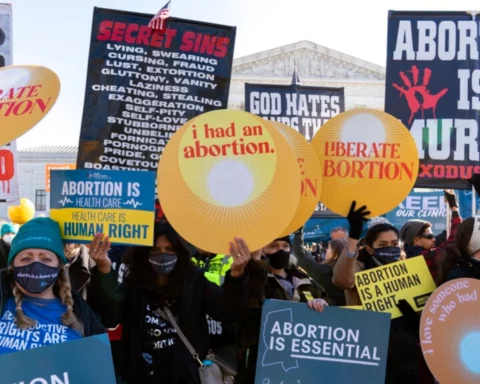WASHINGTON – The tweet came just hours after the high court dismissed a long-shot lawsuit brought by the Texas attorney general against four battleground states that Trump lost to President-elect Joe Biden. The suit sought to overturn the election results, but the court refused to even consider the case.
It was not the first time the Supreme Court had angered Trump with an unfriendly ruling. Just five days earlier, the justices had unanimously ruled against another Republican attempt to undo Biden’s victory in Pennsylvania.
While the court declined to be drawn into Trump’s improbable quest to undo the election results, the outgoing president could still claim bragging rights for making the Supreme Court — and the broader federal judiciary — more conservative.
For a one-term president, Trump has had a remarkable run of good luck with his Supreme Court appointments. In just four years, he has appointed three justices — more than any other president in one term since Richard M. Nixon — helping to usher in a dramatic ideological shift on the bench by forging a new 6-3 conservative majority.
While Trump’s first two Supreme Court picks — Neil Gorsuch and Brett Kavanaugh — succeeded other Republican-appointed conservative justices, his third and final appointee, Amy Coney Barrett, replaced her polar opposite, the late liberal icon Ruth Bader Ginsburg.
“It’s a court with a 6-3 supermajority after years of being finely balanced 5-4 between conservatives and liberals,” said Melissa Murray, a professor at the New York University School of Law and a co-host of “Strict Scrutiny,” a podcast about the Supreme Court.
With a 5-4 conservative majority, just one conservative defection could result in a liberal outcome, Murray noted. That decisive fifth vote was often cast by moderate-to-conservative Chief Justice John Roberts.
However, with an ironclad 6-3 supermajority made up of more conservative justices, “that is, I think, a very different calculus going forward,” she said, adding that Roberts’ vote is no longer pivotal.
Moreover, the Trump appointees’ relative youth will ensure their longevity on the court. Their average age is 52.
At 48, Barrett is the youngest and 39 years junior to her predecessor. That means that long after Trump leaves office, his impact on the Supreme Court will continue to be felt, said Andrew Hessick, a professor of law at the University of North Carolina.
“They will be potentially on the bench, all of them, for 30 years plus, and that is a very long time and that can have a really significant impact on particular rights,” said Hessick.
The high court’s influence could, in turn, be felt across the federal judiciary, where Trump has appointed more than 200 solidly conservative judges, Hessick said.
Judicial drift
In recent decades, several Republican-appointed justices have drifted to the left, raising the possibility that one or more of Trump’s appointees will follow in their footsteps. However, the Trump appointees are “more ideologically fixed” in their views, Murray said.
“So I think there are real questions about whether or not you were going to see the same kind of drift over time,” she said.
To be sure, both Gorsuch and Kavanaugh, to the dismay of some conservatives, have occasionally sided with the court’s liberal wing. Gorsuch, for example, wrote a landmark opinion in June saying that a 1964 law protects LGBTQ workers from discrimination.
The decision was supported by the court’s four liberals at the time as well as Chief Justice Roberts.
Yet the court has become decidedly more conservative than it was four years ago, when Trump took office. According to a widely cited measure of judicial ideology, the Supreme Court has gravitated to the right over the past two years, with Roberts and Kavanaugh now in the middle.
Adam Feldman, creator of Empirical SCOTUS, a blog about the Supreme Court, said Trump “shifted the court to the right.”
“This is clear from the evidence we have from the last couple of terms,” Feldman said.
Advancing religious freedom
While polls show Americans are growing increasingly less religious, religious freedom has become something of a cause celebre among many conservatives, with the high court taking what Murray calls “a more forceful interpretation” of the constitutional right to the free exercise of religion.
Just this year, the justices delivered several major victories to religious liberty advocates, ruling in favor of public funding for religious schools, giving religious schools broad authority to hire and fire teachers, and upholding the Trump administration’s plan to exempt employers from the Affordable Care Act’s contraceptive mandate on religious and moral grounds.
With Barrett’s appointment, the court has adopted an even more aggressive stance on religious liberty. In November, in a departure from two earlier rulings, the court blocked New York’s restrictions on in-person religious services during the pandemic as a burden on religious freedom. Critics said the court was putting religious freedom ahead of public health.
Deference to executive power
With Trump resorting to executive orders to implement controversial policies, the perennial constitutional issue of executive power made several appearances before the court in recent years. Generally speaking, conservative justices subscribe to a more robust notion of presidential powers. Yet while the court sided with the Trump administration in some cases, it pushed back in others.
Saikrishna Prakash, the James Munroe Distinguished Professor of Law at the University of Virginia, noted that on the question of the president’s constitutional authority, Trump probably lost more cases than he won. But on other questions pertaining to the executive branch, the record is mixed.
“But that’s not uncommon,” Prakash said in an interview. “Presidents don’t always win. They don’t always lose.”
The court’s most controversial decision came in 2018 when it rejected a state challenge to Trump’s executive order to impose a travel ban on citizens of eight mostly Muslim-majority countries.
Writing on behalf of the five-justice conservative majority, Roberts said that the Immigration and Nationality Act gave the president “broad discretion” to suspend the entry of noncitizens into the United States.
Another victory for Trump came in 2019 when the court allowed his use of emergency powers to divert billions of dollars in military funds for the construction of a controversial wall along the U.S.-Mexico border.
Along the way, the Trump administration suffered major setbacks in the Supreme Court. In 2019, justices ruled 5-4 against the administration’s plan to add a question on citizenship to the 2020 census. In June 2020, the court prevented the administration from ending the Deferred Action for Childhood Arrivals (DACA) program that protects many young undocumented immigrants from deportation.
And in one of two cases involving subpoenas for Trump’s financial records, the justices rejected Trump’s claim of absolute immunity from criminal subpoenas.






